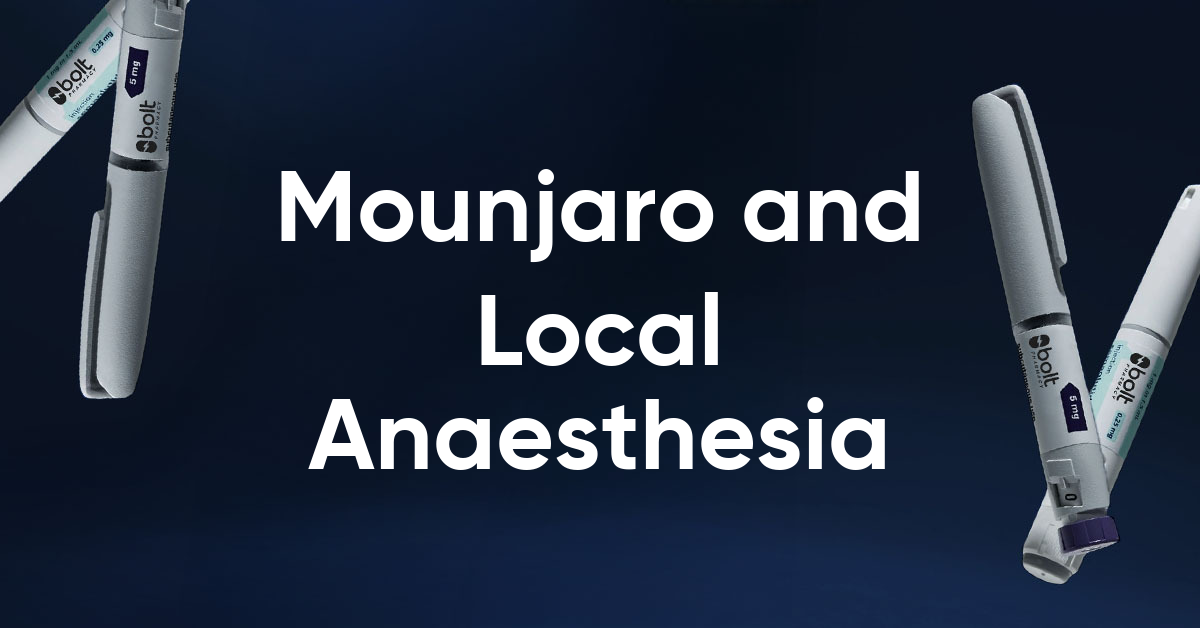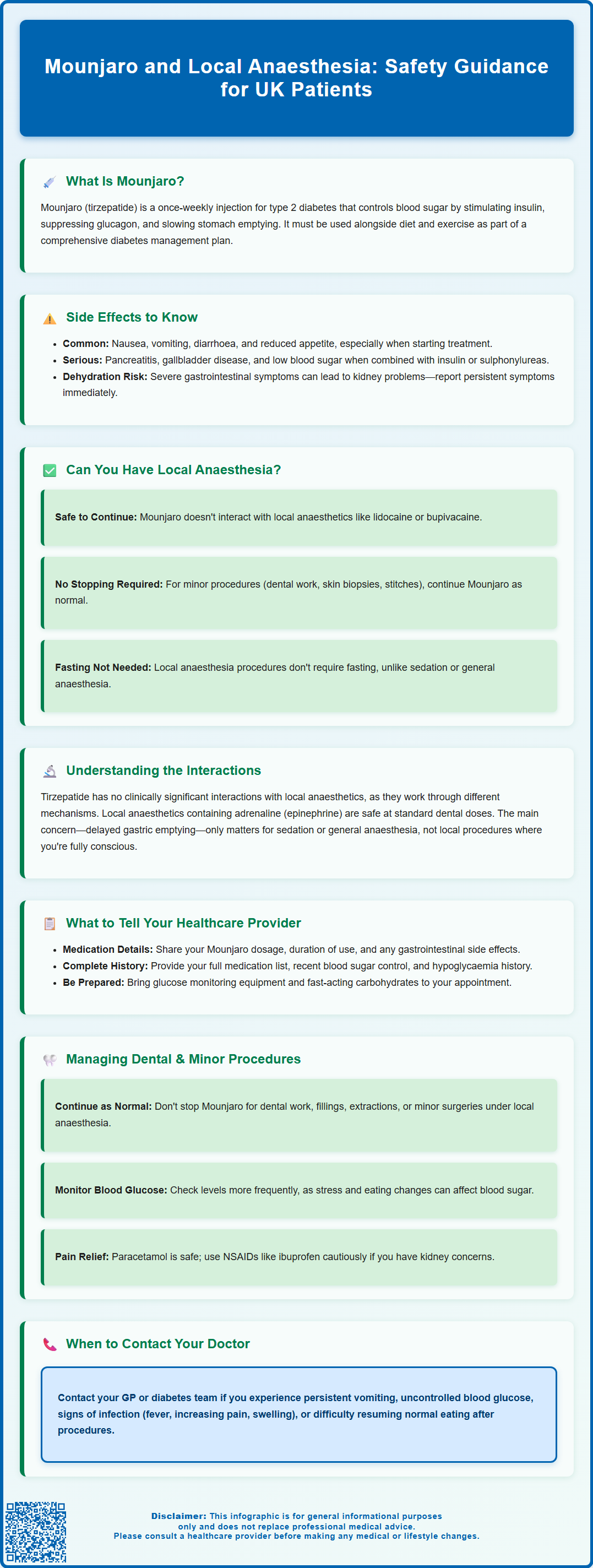Wegovy®
A weekly GLP-1 treatment proven to reduce hunger and support meaningful, long-term fat loss.
- ~16.9% average body weight loss
- Boosts metabolic & cardiovascular health
- Proven, long-established safety profile
- Weekly injection, easy to use

Mounjaro (tirzepatide) is a once-weekly injectable medication licensed in the UK for treating type 2 diabetes in adults. As a dual GIP and GLP-1 receptor agonist, it helps regulate blood sugar whilst slowing gastric emptying. Many patients taking Mounjaro require dental work or minor surgical procedures involving local anaesthesia and may wonder whether their medication affects these interventions. Understanding the relationship between Mounjaro and local anaesthesia is important for safe procedural planning. This article examines the compatibility of tirzepatide with local anaesthetic procedures, potential considerations, and practical guidance for patients and healthcare professionals in the UK.
Summary: Patients taking Mounjaro can safely receive local anaesthesia for dental and minor surgical procedures without discontinuing the medication.
Mounjaro (tirzepatide) is a prescription medicine licensed in the UK for the treatment of type 2 diabetes mellitus in adults. It belongs to a novel class of medications known as dual glucose-dependent insulinotropic polypeptide (GIP) and glucagon-like peptide-1 (GLP-1) receptor agonists. Mounjaro is administered once weekly via subcutaneous injection and works by mimicking the action of naturally occurring incretin hormones.
The mechanism of action involves stimulating insulin secretion when blood glucose levels are elevated, whilst simultaneously suppressing glucagon release. This dual action helps to regulate blood sugar levels. Clinical trials (SURPASS programme) have shown tirzepatide's effectiveness in glycaemic control. Additionally, tirzepatide slows gastric emptying, which prolongs the sensation of fullness after eating and contributes to weight reduction—a beneficial effect for many patients with type 2 diabetes who are overweight or obese.
Common adverse effects include gastrointestinal symptoms such as nausea, vomiting, diarrhoea, and decreased appetite, particularly during dose escalation. These effects typically diminish over time as the body adjusts to the medication. More serious but rare adverse effects include pancreatitis, gallbladder disease, and hypoglycaemia (especially when used in combination with insulin or sulphonylureas). Patients with diabetic retinopathy should be monitored as rapid improvement in glucose control may temporarily worsen retinopathy. Persistent severe gastrointestinal symptoms may lead to dehydration and acute kidney injury.
Mounjaro is prescribed as part of a comprehensive treatment plan that includes dietary modification and increased physical activity. The Medicines and Healthcare products Regulatory Agency (MHRA) has approved its use, and NICE guidance supports its use for specific patient groups with type 2 diabetes. Understanding how Mounjaro works is essential when considering its interaction with other medical interventions, including procedures requiring local anaesthesia.
If you experience any suspected side effects, report them via the MHRA Yellow Card scheme (yellowcard.mhra.gov.uk).
Yes, patients taking Mounjaro can generally receive local anaesthesia safely. There is no official contraindication to the use of local anaesthetic agents in individuals prescribed tirzepatide. Local anaesthetics such as lidocaine, articaine, and bupivacaine work by blocking sodium channels in nerve fibres, temporarily preventing pain signals from reaching the brain. This mechanism of action does not directly interact with the GIP/GLP-1 receptor pathways that Mounjaro affects.
For procedures involving only local anaesthesia, tirzepatide is usually continued and fasting is not typically required. However, it is important to recognise that delayed gastric emptying—a known pharmacological effect of Mounjaro—may have implications for certain procedures, particularly those requiring sedation or general anaesthesia. For straightforward local anaesthetic procedures such as dental fillings, minor skin biopsies, or suturing of lacerations, gastric emptying is not typically a concern, and Mounjaro does not need to be discontinued.
Patient safety considerations include ensuring that your healthcare provider is aware of all medications you are taking, including Mounjaro. This allows them to tailor their approach appropriately and monitor for any unexpected responses. If you experience significant gastrointestinal symptoms from Mounjaro—such as persistent nausea or vomiting—it is advisable to inform your dentist or procedural clinician, as these symptoms may affect your comfort during and after the procedure.
For most minor procedures performed under local anaesthesia alone, no special precautions regarding Mounjaro are required, though standard diabetes considerations apply. The medication can be continued as prescribed, and the procedure can proceed as planned. If you are also taking insulin or sulphonylureas, discuss with your clinician how to prevent hypoglycaemia if your meal patterns change around the procedure. If you have concerns about a specific procedure, discuss these with both your prescribing clinician and the healthcare professional performing the intervention.

No clinically significant pharmacological interactions are expected between tirzepatide (Mounjaro) and commonly used local anaesthetic agents, according to the Mounjaro Summary of Product Characteristics. Local anaesthetics act peripherally at nerve endings and do not significantly affect blood glucose regulation, incretin hormone pathways, or gastric motility. Similarly, Mounjaro does not alter the metabolism or efficacy of local anaesthetics such as lidocaine, prilocaine, or mepivacaine.
The primary consideration relates to Mounjaro's effect on gastric emptying rather than a direct drug-drug interaction. Delayed gastric emptying increases the volume of gastric contents, which theoretically raises the risk of aspiration if a patient were to vomit or regurgitate during a procedure. However, this concern is relevant primarily for procedures involving sedation or general anaesthesia, not for local anaesthesia administered whilst the patient is fully conscious and alert.
Vasoconstrictors such as adrenaline (epinephrine) are frequently combined with local anaesthetics to prolong their duration of action and reduce bleeding. These agents cause temporary increases in heart rate and blood pressure but do not interact with Mounjaro's mechanism of action. Patients with well-controlled type 2 diabetes taking Mounjaro can safely receive local anaesthetics containing adrenaline at standard dental doses, provided there are no other contraindications such as severe cardiovascular disease.
It is worth noting that stress and anxiety associated with dental or surgical procedures can affect blood glucose levels. Patients should monitor their blood sugar as usual and ensure they have eaten appropriately before their appointment, unless specifically instructed to fast. If you experience hypoglycaemia symptoms—such as sweating, tremor, or confusion—inform your healthcare provider immediately, as this may require glucose administration and temporary postponement of the procedure.
Open communication with your healthcare team is essential to ensure safe and effective care. Before any procedure involving local anaesthesia, inform your dentist, surgeon, or procedural clinician that you are taking Mounjaro. Provide details about your dosage, how long you have been taking the medication, and whether you have experienced any adverse effects, particularly gastrointestinal symptoms.
Key information to share includes:
Your complete medication list, including insulin, other diabetes medications, anticoagulants, and over-the-counter supplements
Your most recent HbA1c and blood glucose control status
Any history of hypoglycaemia or difficulty managing blood sugar levels
Recent episodes of nausea, vomiting, or abdominal discomfort
Any known allergies to local anaesthetics or other medications
Your healthcare provider may wish to liaise with your GP or diabetes specialist if the planned procedure is complex or if there are concerns about your diabetes management. This collaborative approach ensures that all aspects of your care are coordinated and that any necessary adjustments to your treatment plan are made safely.
For routine procedures such as dental work, minor dermatological interventions, or joint injections, fasting is generally not required. Continue taking Mounjaro as prescribed unless your doctor advises otherwise. Ensure you have eaten a light meal before your appointment to maintain stable blood glucose levels, and bring your glucose monitoring equipment and a source of fast-acting carbohydrate (such as glucose tablets) in case of hypoglycaemia.
If you take insulin or sulphonylureas, discuss with your clinician whether dose adjustments are needed if meals will be missed or delayed due to the procedure.
If your procedure is scheduled early in the morning and you typically inject Mounjaro on that day, consult your prescribing clinician about whether to administer your dose before or after the procedure. For most local anaesthetic procedures, timing is flexible, but individualised advice is always preferable.
For most dental and minor surgical procedures performed under local anaesthesia, Mounjaro does not need to be stopped. The medication can be continued according to your usual weekly schedule. Dental treatments such as fillings, extractions, root canal therapy, and periodontal procedures are all compatible with ongoing Mounjaro therapy, as these interventions do not require general anaesthesia or prolonged fasting.
Practical management tips include:
Maintain your regular dosing schedule: Mounjaro is administered once weekly, and missing a dose may affect your blood glucose control. Unless specifically advised by your doctor, continue your injections as planned.
Monitor blood glucose levels: Stress, infection, or changes in eating patterns around the time of a procedure can affect blood sugar. Check your levels more frequently in the days surrounding your appointment.
Stay hydrated and eat appropriately: Unless you have been instructed to fast, eat a light meal before your procedure to prevent hypoglycaemia. After dental work, you may need to consume soft foods temporarily; plan accordingly to maintain adequate nutrition.
Manage post-procedure discomfort: If you require pain relief following a procedure, paracetamol is generally safe and does not interact with Mounjaro. Non-steroidal anti-inflammatory drugs (NSAIDs) such as ibuprofen can be used cautiously but discuss this with your healthcare provider, particularly if you have kidney concerns or are at risk of dehydration.
When to contact your GP or diabetes team:
If you develop persistent nausea or vomiting that prevents you from eating or taking medications
If your blood glucose levels become difficult to control before or after the procedure
If you experience signs of infection (fever, increasing pain, swelling, or discharge) following a surgical procedure
If you have concerns about resuming normal eating after dental work
For more extensive procedures that may require sedation or general anaesthesia, UK guidance (Centre for Perioperative Care/Association of Anaesthetists) generally advises continuing GLP-1/GIP agonists for elective procedures. However, if you have significant gastrointestinal symptoms or are in the dose escalation phase, discuss this with your anaesthetist who will assess your individual aspiration risk. Always follow the advice of your medical team and do not stop or alter your Mounjaro regimen without professional guidance.
No, Mounjaro does not need to be stopped for routine dental procedures performed under local anaesthesia. Continue your usual weekly dosing schedule unless your doctor advises otherwise.
Yes, local anaesthetics containing adrenaline (epinephrine) can be used safely in patients taking Mounjaro, as there is no interaction between these agents and tirzepatide's mechanism of action.
Inform your healthcare provider that you take Mounjaro, including your dosage, duration of treatment, and any gastrointestinal symptoms. Also share your complete medication list and recent blood glucose control status to ensure coordinated care.
The health-related content published on this site is based on credible scientific sources and is periodically reviewed to ensure accuracy and relevance. Although we aim to reflect the most current medical knowledge, the material is meant for general education and awareness only.
The information on this site is not a substitute for professional medical advice. For any health concerns, please speak with a qualified medical professional. By using this information, you acknowledge responsibility for any decisions made and understand we are not liable for any consequences that may result.
Lorem ipsum dolor sit amet, consectetur adipiscing elit, sed do eiusmod tempor incididunt ut labore et dolore magna aliqua. Ut enim ad minim veniam, quis nostrud exercitation ullamco laboris nisi ut aliquip ex ea commodo consequat. Duis aute irure dolor in reprehenderit in voluptate velit esse cillum dolore eu fugiat nulla pariatur.
Block quote
Ordered list
Unordered list
Bold text
Emphasis
Superscript
Subscript